Maltøl, or Norwegian farmhouse ale
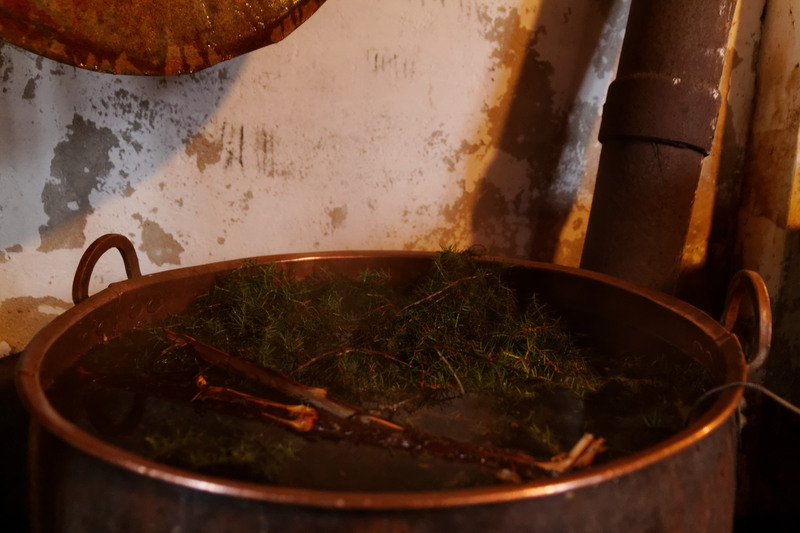
Making juniper infusion, Kaupanger |
This seems like a good time to summarize what I've learned about Norwegian farmhouse ale during and after the May trip. There is still a lot of material to go through, and much more to learn, so this summary is still somewhat provisional, but much better and more firmly grounded than the previous one.
By now it's clear that the correct name for Norwegian farmhouse ale is maltøl. As with Lithuanian kaimiškas, and probably also Finnish sahti, this is an umbrella term for several very different styles of beer. It does seem, however, that this was the term used for this type of beer over nearly the entire country (except where it was, and is, called konnjøl), regardless of the differences.
So what do these beers have in common? The basic ingredients seem to be the same everywhere: juniper infusion instead of water, barley malts, hops, and yeast. Hops are generally used very sparingly, mainly to prevent infection, but also as a bittering agent together with the juniper. There's no filtering, and no attempt to carbonate the beer. Alcohol strengths vary widely. Colour seems to range from amber to dark.
On the process side of things there are also huge differences (to which I'll return below), but one thing seems constant: the use of big wood-fired copper or iron kettles. An open question is to what degree these affect the flavour. From my own experiments I know that the heat from the wood fire definitely does affect the colour.
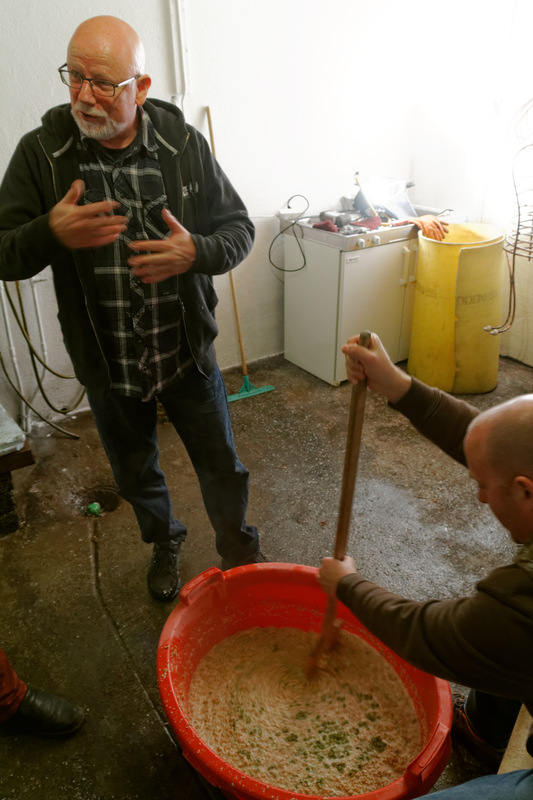
Mashing, Voss |
Also abundantly clear by now is that while the places where maltøl survives today look like small, isolated islands, they are actually the mountaintops of a sunken continent. Farmhouse ale was widespread all over Norway south of the Arctic circle as late as 1850, and even as late as 1910 there was still traditional brewing in most of the country. You can watch the decline on the interactive map.
Although some people describe the tradition as unchanged for thousands of years that's obviously untrue, even if the tradition almost certainly is unbroken for thousands of years. There have been many changes over the centuries, of a number of different kinds. The biggest was perhaps the transition to an all-malt beer. Other changes were the introduction of copper kettles, the boiling of the wort (probably), the reuse of yeast (probably), the introduction of hops, and a few more.
Geographically the brewing that survives is fairly spread out, as you can see from the map below. I've only marked the spots where I know for certain that farmhouse brewing exists today, so note that there are many missing spots near the ones I've marked.
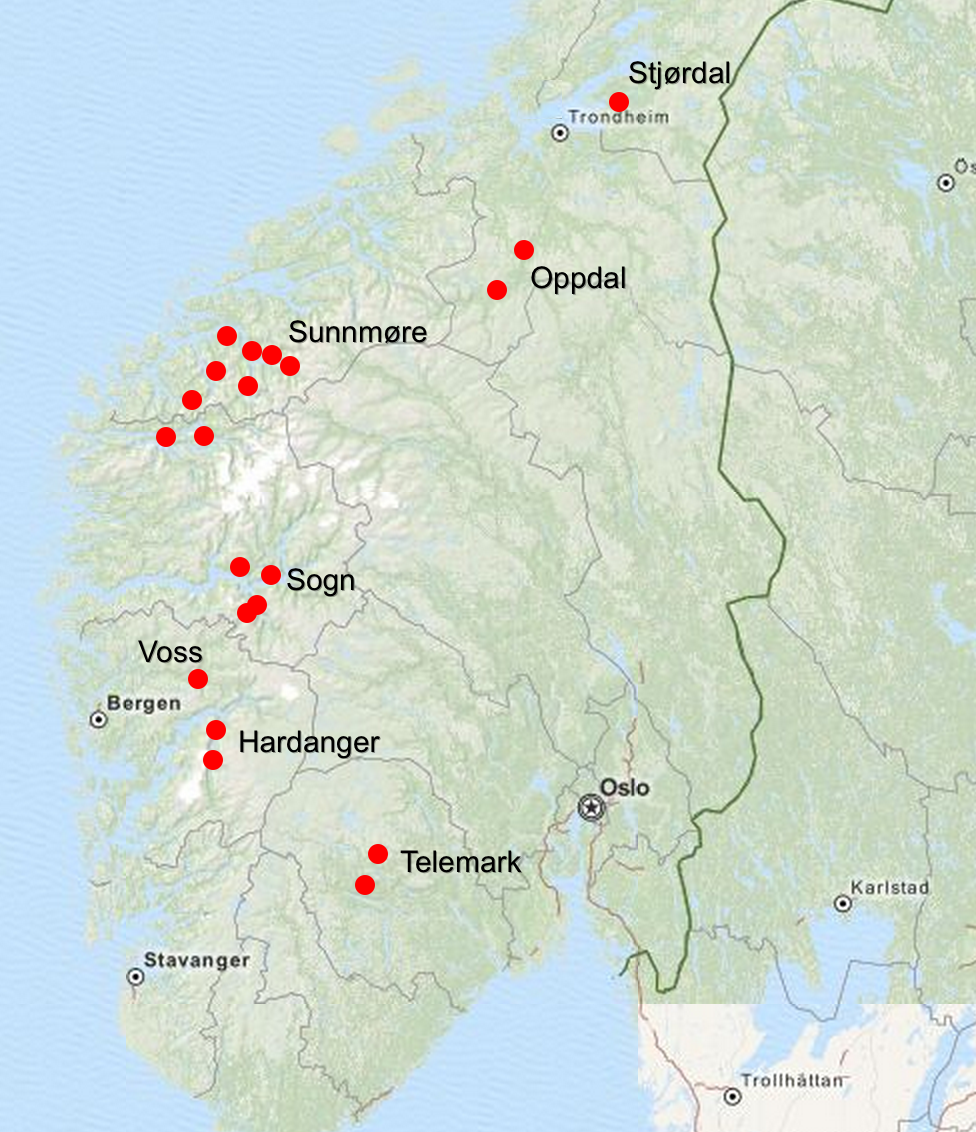
Farmhouse brewing today (base map from OpenStreetMap, OpenStreetMap license) |
Going through the regions one by one:
- Voss
- This stands out as one of the two key farmhouse areas in Norway. There are lots of farmhouse brewers here, and the original style is amazingly well preserved. They've preserved the ancestral Norwegian yeast strains (kveik), as well as Norwegian hop varieties. As late as two decades ago, people were even making their own malts. What is more, the beer is really, really good. More on that below. The process of making the traditional beers commercially available has begun, which is good.
- Hardanger
- I have made little progress on this region, but it seems to still have a good number of active brewers, and to be very similar to Voss. The kveik lives on, but how well preserved it is and whether it's like the one from Voss is unknown. More below.
- Sogn
- I know there are many brewers. I also know they brew in very different ways. The tradition seems much less well preserved here, but the style and process are still mostly traditional. Yeast, malts, and hops are now all imported.
- Sunnmøre
- Again there are many brewers, and they are quite spread out geographically, but they are actually fairly well organized. How well preserved the original styles are is not clear, but there are still people who know how to brew in the traditional way and make their own malts. The kveik definitely lives on. I've smelled one, and it seems very unlike the ones from Voss. Over the next couple of months I should learn a lot more about this aspect.
- Oppdal
- There is a fairly small cluster of brewers here, but at least some of them have preserved the tradition amazingly well. The kveik is dead, and the hops seem to be gone, but they do make their own malts.
- Stjørdal
- This is the other key area of Norwegian farmhouse brewing with literally hundreds of brewers, nearly all of them making their own malts. The kveik is dead here, and the hops are imported, but the original style and processes are preserved. They have even begun the process of commercializing the farmhouse ales, which is very promising. More about their beers below.
- Telemark
- Little is known about this region, but my impression is that brewing died out in the 70s and 80s, and was then revived. Malts, hops, and yeast appear to be imported. I have been in touch with a group of brewers here about visiting them, but they stopped responding so nothing came of it. I will try again.
Identifying separate styles of beer out of the tangled mess of data is by no means easy, and for a long time it wasn't even clear that it was a good idea. By now, however, a few clusters are beginning to emerge. All of these styles share the commonalities listed above, so I pass over those below. I'm restricting myself to the styles that are still alive today.
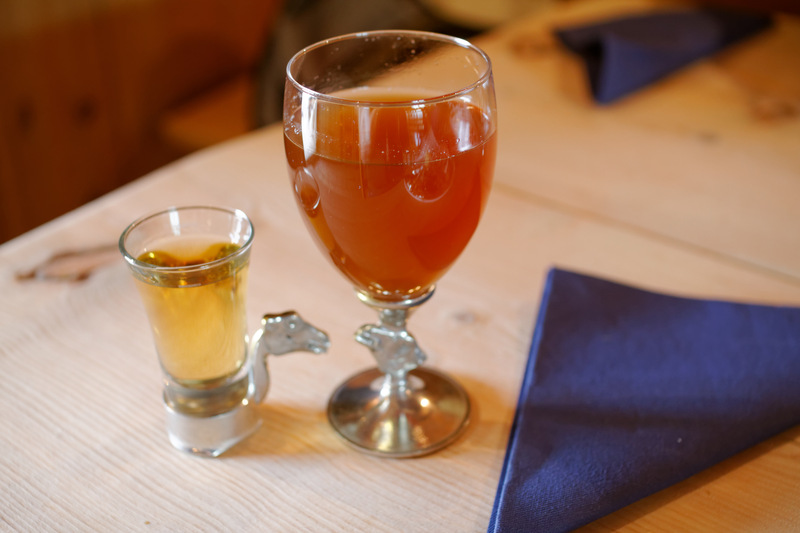
Vossaøl (right) |
Vossaøl/Hardangerøl
These are quite strong beers (7-8%), made from pale unsmoked malts, with a long mash of at least 3 hours, and a boil of 3-4 hours. The result is amber or reddish. A key factor in the character of these beers is the use of kveik. The main flavours are an orangey aroma from the kveik, as well as juniper taste, and key to brewing a good one seems to be blending the kveik flavour harmonically in with the juniper, while balancing the hop/juniper bitterness with the malty sweetness.
We helped brew one beer like this in Voss, and tasted two others, which were quite similar. Afterwards, Voss Bryggeri brewed a commercial version following much the same recipe, producing a beer rather like the first three. I've later brewed two more with modern equipment, and again they came out much like the originals. So it's clear that the different vossaøl are all very close in flavour, and consistent enough to be considered a single style. The flavour is totally unlike anything else I've ever had, so I have no hesitation naming this a separate style.
Discussions with two home brewers from Hardanger (which is not far from Voss) indicate that the process is the same there. Interestingly, the local history society in Hardanger published a recipe from 1898 which seems to follow the same outline: mashing 3-4 hours, boiling "preferably for several hours". The process from 1898 seems to be to split the wort and boil the first part with the hops, and the last part for several hours. Frustratingly, the recipe is a bit ambiguous there.
Anyway, probably the maltøl from these two areas are similar enough to form a single type. Whether it's one style or two hinges on the flavour of kveik from Hardanger, and that flavour is still totally unknown to me. It may be that it the combined style should be named hardangerøl, since there are hints that it was a recognized beer style in Norway two centuries ago.
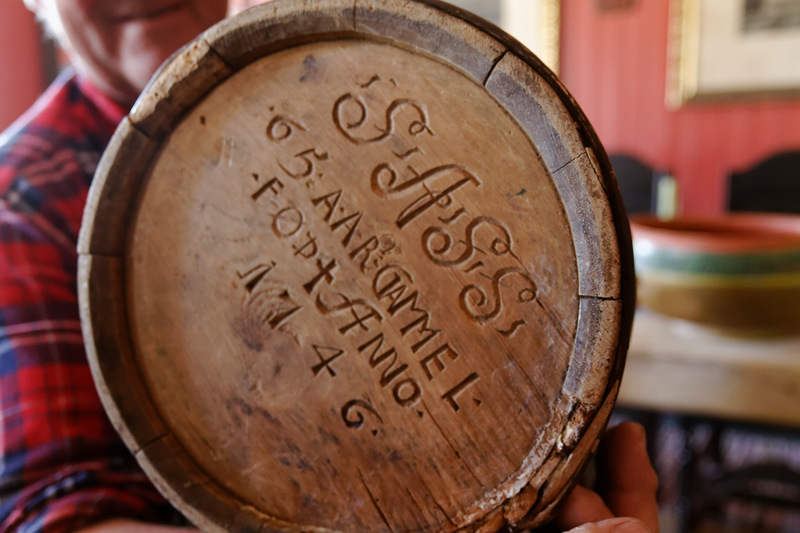
Beer vat for raw ale, Storli near Oppdal |
Råøl
The råøl (raw ale) is characterized by the wort not being boiled. Typically, a small part of the wort is taken off and boiled with hops, and the result then added to the unboiled wort and fermented directly. It seems the malt is lightly smoked some places. Some places they use kveik, other places bread yeast where the kveik is gone.
Geographically, these beers are spread out somewhat. We found one in Oppland, but it's also found in Sunnmøre. It used to be brewed in Stranda (and might still be), and it's still brewed in Hornindal just across the province border to Sogn og Fjordane. It was brewed in Aurland as late as the 1990s, and might still be alive there. It probably lives in more places without me knowing about it yet.
The raw ale must, as far as I can tell, vary quite a lot, so perhaps this is in reality more than a single beer style, but since it stands out so clearly in terms of both flavour and process from other maltøl it seems to deserve a category of its own. Although I have yet to try it, I would assume that raw ale made with kveik must stand out quite clearly from the ones made with bread yeast. I hope to soon get my hands on a kveik traditionally used for raw ale, and then I will be able to check.
Stjørdalsøl
These beers are from the region around Stjørdal near Trondheim, and this is a style that's already established among Norwegian beer enthusiasts. Everyone knows about stjørdalsøl. Within the style there is considerable variety, and some brewers like to use more specific terms, like Hegra maltøl, but it really does seem like a single style. The defining characteristic is that the brewers make their own malts, and the way they do it: usually lightly roasted, and between somewhat smoked to heavily smoked.
The beers are generally 5-7.5% alcohol, dark amber to dark brown, and defined by the malt flavour. The locals like to say that "if you have good malts, you can hardly fail to make good beer," showing what emphasis they place on the malts. As far as I know, all of these beers have a smoke flavour, but it varies from light and delicate to intense and overpowering. The baking yeast they use gives a rough, fruity flavour to the beer that goes well with the smoky malts.
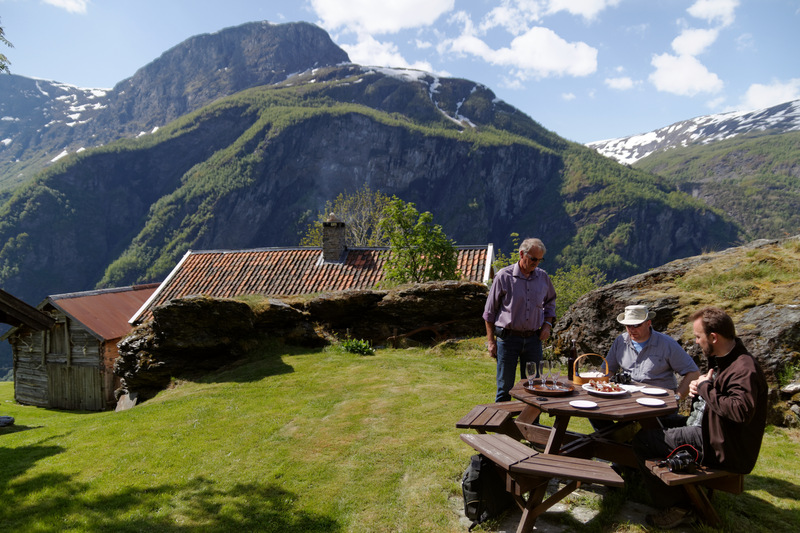
Lunch with maltøl, Flåm |
Others
There are lots of maltøl that don't fall within one of these three styles. The one I helped brew in Sogndal, for example, as well as the one from Holo Gardstun, and a whole range of others. At the moment I am not sure how to classify these, so for now I think they are best described simply as generic "maltøl".
After about a year of serious research into the current state of Norwegian farmhouse ale, this is as far as I've gotten. I have a lot more detail than what's given here, of course, but this is the big picture. No doubt it will change as I learn more.
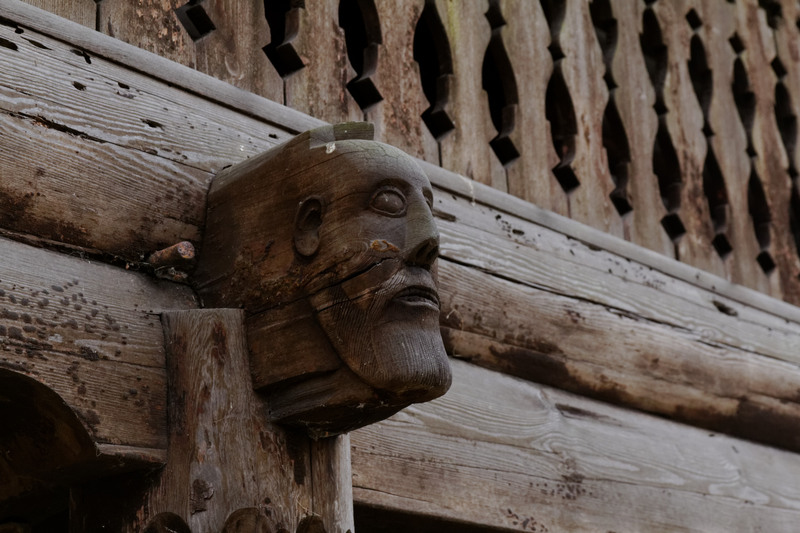
Carved beam, Kaupanger |
Similar posts
Norwegian farmhouse ale styles
People are confused over what to call Norwegian farmhouse ale and what styles there are
Read | 2017-01-19 19:23
Farmhouse ales of Europe
Having surveyed the state of farmhouse brewing in Norway it's time to look at the same thing in Europe generally
Read | 2014-10-18 16:46
Norwegian farmhouse ale
It's a well-kept secret that in Norway there exists a homebrewing tradition completely separate from the modern homebrewing that's taken off in the last few decades
Read | 2013-10-27 13:24
Comments
Viggo - 2014-10-18 13:45:15
It looks like that in Trøndelag, they place great emphasis on the malts, while in Western Norway, the yeast is more important. Unfortunately, no-one has preserved both the malt and the yeast traditions.
By the way, you mention that they still use Norwegian hop varieties in Voss. Have you written about this somewhere?
Lars Marius - 2014-10-18 13:54:08
Yes, that's a pretty good summary. What's interesting is that in Voss there are still people who know how to make their own malts, and I know malting took place at least as late as the 1990s. There's also a guy who's been teaching courses in malting in Voss. So Voss could easily bring back both the native malts and the native hops. In my opinion they definitely should, but of course that's easy for me to say.
I have not written about the Voss hop varieties anywhere because so far the only thing I know is that they exist. Planteforsk has gathered a number of Norwegian hops (about 40) and analyzed them, but unfortunately none were from Voss.
In general, I think Norwegian hops are probably not that interesting compared to malts, yeast, and process/equipment. Wild hops don't have that much bitterness or aroma (in general), and Norwegian brewing has traditionally not used much of it, anyway. It should be explored, of course, but ... there's so much to research I don't know when I'll get round to it.
Svein - 2014-12-02 14:36:23
Very interesting summing up. I think this makes for a good start on a book on Norwegian farmhous brewing and ales ;)
If you get the chance you should talk to Øystein Meland, one of the two owners of Balder Bryggeri in Leikanger. Øystein used to brew together with his father, a well known and very experienced home brewer in Leikanger. Øystein's father also made his own malt. I am not sure whether he used kveik or similar traditional yeast. You would have to ask Øystein. Øystein's father came from Hardanger so possibly he his home brewing was based on the Hardanger tradition.
Martin Warren - 2015-01-17 13:39:56
I am delighted to have discovered your blog and I am devouring its content. Thank you. As I write this I am only a couple of kilometres from the NCYC! I hope to obtain some kveik from Chris Bond but please would you help me with the pronunciation? Cheers, from Poppyland
Lars Marius - 2015-01-17 14:03:05
@Svein: Thank you. I will get in touch with them.
@Martin: Thank you. The pronunciation non-trivial, but doable. The consonants are as in English. The 'e' is pronounced like 'a' in 'cat'. The 'i' is pronounced 'ee', but short. So 'k-v-a-ee-k'.
John Sauer - 2020-05-31 01:17:15
This article is an incredible resource for anyone looking into brewing a similar style. I'm from the states and used Imperial Hothead which is a Kaveik yeast to ferment what the midwesterners call "lawnmower beer" which is a corn heavy cream ale. It is a great yeast for homebrewers that don't have great temperature control for fermentation. I ran a test later that to me showed, cold fermentation tasted significantly cleaner but the hot ferment was still very good.
The shining example here of a lawnmower cream ale is known as "Spotted Cow." I think Northern Brewer has a clone called "Freckled Heffer."
Could you please refresh the 1898 recipe link? Do you have any leads on other Kaveik style yeasts available for home brewers? Also, when is juniper in season to cut a few branches for a brew?
Thank you for your great post!
Lars Marius Garshol - 2020-06-02 13:44:29
@John: Here is the updated 1898 link. Unfortunately, the text itself has never been online: http://www.hardanger-historielag.com/no/bibliografi--bokkjoep/bibliografi/k/kor-ein-bryggjar-hardangeroel.aspx
Please spell it "kveik". It's pronounced without any vowel in between the "k" and the "v".
Other kveik yeasts? There are lots of them. Just search with google. You can also find a list of the originals here, with links to some commercial versions: http://www.garshol.priv.no/download/farmhouse/kveik.html
Juniper can be cut any time of year. The farmhouse brewers cut it when they need it, and don't worry about seasonal differences.
CHRISTOF RAMPITSCH - 2020-11-06 17:48:11
I have just brewed a Juniper-based Maltøl, based heavily on your blog - although at a far smaller volume (about 15 litres, because I am not sure how it is all going to taste!). I live in Canada, so I was able to source juniper and even Kveik, as there is a company here that propagates it (it was a strain called "Voss"; the company is Escarpment Labs in Guelph, ON). Thanks for all the knowledge as there is very little on the internet - I had no idea it was such a deeply traditional style, uncontaminated by the Reinheitsgebot. Makes sense though! The few Nordic Saisons that I have been able to get here (from Iceland, and one local) have been very good and it is a style I would like to perfect.